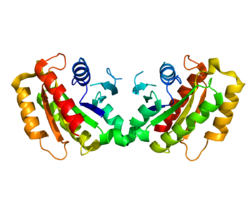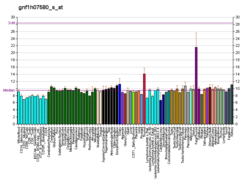LRRK2
Leucine-rich repeat kinase 2(LRRK2), also known asdardarin(from the Basque word "dardara" which means trembling) andPARK8(from early identified association with Parkinson's disease), is a large, multifunctionalkinaseenzymethat in humans is encoded by theLRRK2gene.[5][6]LRRK2 is a member of theleucine-rich repeatkinase family. Variants of this gene are associated with an increased risk ofParkinson's diseaseandCrohn's disease.[5][6]
Function[edit]
The LRRK2 gene encodes aproteinwith anarmadillo repeats(ARM) region, anankyrin repeat(ANK) region, aleucine-rich repeat(LRR) domain, akinasedomain, a RAS domain, aGTPasedomain, and aWD40domain. The protein is present largely in the cytoplasm but also associates with themitochondrial outer membrane.
LRRK2 interacts with theC-terminalR2RING finger domainofparkin,and parkin interacted with the COR domain of LRRK2. Expression of mutant LRRK2 inducedapoptoticcell death in neuroblastoma cells and in mouse cortical neurons.[7]
Expression of LRRK2 mutants implicated in autosomal dominant Parkinson's disease causes shortening and simplification of the dendritic tree in vivo and in cultured neurons.[8]This is mediated in part by alterations in macroautophagy,[9][10][11][12][13]and can be prevented by protein kinase A regulation of the autophagy protein LC3.[14]The G2019S and R1441C mutations elicit post-synaptic calcium imbalance, leading to excess mitochondrial clearance from dendrites by mitophagy.[15]LRRK2 is also a substrate for chaperone-mediated autophagy.[16]
Clinical significance[edit]
Mutationsin this gene have been associated withParkinson's diseasetype 8.[17][18]
The Gly2019Ser mutation results in enhanced kinase activity, and is a relatively common cause of familial Parkinson's disease in Caucasians.[19]It may also cause sporadic Parkinson's disease. The mutated Gly amino acid is conserved in all kinase domains of all species.
The Gly2019Ser mutation is one of a small number of LRRK2 mutations proven to cause Parkinson's disease. Of these, Gly2019Ser is the most common in the Western World, accounting for ~2% of all Parkinson's disease cases in North American Caucasians. This mutation is enriched in certain populations, being found in approximately 20% of all Ashkenazi Jewish Parkinson's disease patients and in approximately 40% of all Parkinson's disease patients of North African Berber Arab ancestry.[20][21]
Unexpectedly, genomewide association studies have found an association between LRRK2 andCrohn's diseaseas well as with Parkinson's disease, suggesting that the two diseases share common pathways.[22][23]
Attempts have been made to grow crystals of the LRRK2 aboard theInternational Space Station,as the low-gravity environment renders the protein less susceptible to sedimentation and convection, and thus more crystallizable.[24]
Mutations in the LRRK2 gene is the main factor in contributing to the genetic development of Parkinson's disease, and over 100 mutations in this gene have been shown to increase the chance of PD development. These mutations are most commonly seen in North African Arab Berber, Chinese, and Japanese populations.[25]
References[edit]
- ^abcGRCh38: Ensembl release 89: ENSG00000188906–Ensembl,May 2017
- ^abcGRCm38: Ensembl release 89: ENSMUSG00000036273–Ensembl,May 2017
- ^"Human PubMed Reference:".National Center for Biotechnology Information, U.S. National Library of Medicine.
- ^"Mouse PubMed Reference:".National Center for Biotechnology Information, U.S. National Library of Medicine.
- ^abPaisán-Ruíz C, Jain S, Evans EW, Gilks WP, Simón J, van der Brug M, López de Munain A, Aparicio S, Gil AM, Khan N, Johnson J, Martinez JR, Nicholl D, Carrera IM, Pena AS, de Silva R, Lees A, Martí-Massó JF, Pérez-Tur J, Wood NW, Singleton AB (November 2004)."Cloning of the gene containing mutations that cause PARK8-linked Parkinson's disease".Neuron.44(4): 595–600.doi:10.1016/j.neuron.2004.10.023.PMID15541308.S2CID16688488.
- ^abZimprich A, Biskup S, Leitner P, Lichtner P, Farrer M, Lincoln S, Kachergus J, Hulihan M, Uitti RJ, Calne DB, Stoessl AJ, Pfeiffer RF, Patenge N, Carbajal IC, Vieregge P, Asmus F, Müller-Myhsok B, Dickson DW, Meitinger T, Strom TM, Wszolek ZK, Gasser T (November 2004)."Mutations in LRRK2 cause autosomal-dominant parkinsonism with pleomorphic pathology".Neuron.44(4): 601–7.doi:10.1016/j.neuron.2004.11.005.PMID15541309.S2CID8642468.
- ^Smith WW, Pei Z, Jiang H, Moore DJ, Liang Y, West AB, Dawson VL, Dawson TM, Ross CA (December 2005)."Leucine-rich repeat kinase 2 (LRRK2) interacts with parkin, and mutant LRRK2 induces neuronal degeneration".Proceedings of the National Academy of Sciences of the United States of America.102(51): 18676–81.Bibcode:2005PNAS..10218676S.doi:10.1073/pnas.0508052102.PMC1317945.PMID16352719.
- ^MacLeod D, Dowman J, Hammond R, Leete T, Inoue K, Abeliovich A (November 2006)."The familial Parkinsonism gene LRRK2 regulates neurite process morphology".Neuron.52(4): 587–93.doi:10.1016/j.neuron.2006.10.008.PMID17114044.S2CID16966163.
- ^Plowey ED, Cherra SJ, Liu YJ, Chu CT (May 2008)."Role of autophagy in G2019S-LRRK2-associated neurite shortening in differentiated SH-SY5Y cells".Journal of Neurochemistry.105(3): 1048–56.doi:10.1111/j.1471-4159.2008.05217.x.PMC2361385.PMID18182054.
- ^Friedman LG, Lachenmayer ML, Wang J, He L, Poulose SM, Komatsu M, Holstein GR, Yue Z (May 2012)."Disrupted autophagy leads to dopaminergic axon and dendrite degeneration and promotes presynaptic accumulation of α-synuclein and LRRK2 in the brain".The Journal of Neuroscience.32(22): 7585–93.doi:10.1523/JNEUROSCI.5809-11.2012.PMC3382107.PMID22649237.
- ^Gómez-Suaga P, Luzón-Toro B, Churamani D, Zhang L, Bloor-Young D, Patel S, Woodman PG, Churchill GC, Hilfiker S (February 2012)."Leucine-rich repeat kinase 2 regulates autophagy through a calcium-dependent pathway involving NAADP".Human Molecular Genetics.21(3): 511–25.doi:10.1093/hmg/ddr481.PMC3259011.PMID22012985.
- ^Ramonet D, Daher JP, Lin BM, Stafa K, Kim J, Banerjee R, Westerlund M, Pletnikova O, Glauser L, Yang L, Liu Y, Swing DA, Beal MF, Troncoso JC, McCaffery JM, Jenkins NA, Copeland NG, Galter D, Thomas B, Lee MK, Dawson TM, Dawson VL, Moore DJ (April 2011). Cai H (ed.)."Dopaminergic neuronal loss, reduced neurite complexity and autophagic abnormalities in transgenic mice expressing G2019S mutant LRRK2".PLOS ONE.6(4): e18568.Bibcode:2011PLoSO...618568R.doi:10.1371/journal.pone.0018568.PMC3071839.PMID21494637.
- ^Alegre-Abarrategui J, Christian H, Lufino MM, Mutihac R, Venda LL, Ansorge O, Wade-Martins R (November 2009)."LRRK2 regulates autophagic activity and localizes to specific membrane microdomains in a novel human genomic reporter cellular model".Human Molecular Genetics.18(21): 4022–34.doi:10.1093/hmg/ddp346.PMC2758136.PMID19640926.
- ^Cherra SJ, Kulich SM, Uechi G, Balasubramani M, Mountzouris J, Day BW, Chu CT (August 2010)."Regulation of the autophagy protein LC3 by phosphorylation".The Journal of Cell Biology.190(4): 533–9.doi:10.1083/jcb.201002108.PMC2928022.PMID20713600.
- ^Cherra SJ, Steer E, Gusdon AM, Kiselyov K, Chu CT (February 2013)."Mutant LRRK2 elicits calcium imbalance and depletion of dendritic mitochondria in neurons".The American Journal of Pathology.182(2): 474–84.doi:10.1016/j.ajpath.2012.10.027.PMC3562730.PMID23231918.
- ^Orenstein SJ, Kuo SH, Tasset I, Arias E, Koga H, Fernandez-Carasa I, Cortes E, Honig LS, Dauer W, Consiglio A, Raya A, Sulzer D, Cuervo AM (April 2013)."Interplay of LRRK2 with chaperone-mediated autophagy".Nature Neuroscience.16(4): 394–406.doi:10.1038/nn.3350.PMC3609872.PMID23455607.
- ^"Entrez Gene: LRRK2 leucine-rich repeat kinase 2".
- ^PhD LS (2023-09-18)."Researchers win Breakthrough Prize for Parkinson's genetics discoveries | Parkinson's News Today".parkinsonsnewstoday.Retrieved2023-09-20.
- ^Gilks WP, Abou-Sleiman PM, Gandhi S, Jain S, Singleton A, Lees AJ, Shaw K, Bhatia KP, Bonifati V, Quinn NP, Lynch J, Healy DG, Holton JL, Revesz T, Wood NW (February 2005). "A common LRRK2 mutation in idiopathic Parkinson's disease".Lancet.365(9457): 415–6.doi:10.1016/S0140-6736(05)17830-1.PMID15680457.S2CID36186136.
- ^Healy DG, Falchi M, O'Sullivan SS, Bonifati V, Durr A, Bressman S, et al. (July 2008)."Phenotype, genotype, and worldwide genetic penetrance of LRRK2-associated Parkinson's disease: a case-control study".The Lancet. Neurology.7(7): 583–90.doi:10.1016/S1474-4422(08)70117-0.PMC2832754.PMID18539534.
- ^Lesage S, Dürr A, Tazir M, Lohmann E, Leutenegger AL, Janin S, et al. (January 2006)."LRRK2 G2019S as a cause of Parkinson's disease in North African Arabs".The New England Journal of Medicine.354(4): 422–3.doi:10.1056/NEJMc055540.PMID16436781.
- ^Manolio TA (July 2010)."Genomewide association studies and assessment of the risk of disease".The New England Journal of Medicine.363(2): 166–76.doi:10.1056/NEJMra0905980.PMID20647212.
- ^Nalls MA, Plagnol V, Hernandez DG, Sharma M, Sheerin UM, Saad M, Simón-Sánchez J, Schulte C, Lesage S, Sveinbjörnsdóttir S, Stefánsson K, Martinez M, Hardy J, Heutink P, Brice A, Gasser T, Singleton AB, Wood NW (February 2011)."Imputation of sequence variants for identification of genetic risks for Parkinson's disease: a meta-analysis of genome-wide association studies".Lancet.377(9766): 641–9.doi:10.1016/S0140-6736(10)62345-8.PMC3696507.PMID21292315.
- ^Carreau M (November 14, 2018)."ISS Cargo Missions To Test Soyuz, Deliver New Science".Aviation Week.
A collaboration between the Michael J. Fox Foundation, of New York City, and Merck Research Laboratories, of Kenilworth, New Jersey, will seek to grow crystals of a key gene protein, Leucine-Rich Repeat Kinase 2 (LRRK2), in an effort to advance the search for a cure for Parkinson's disease. Crystals cultured in the absence of gravity are less susceptible to sedimentation and convection, rendering them larger and easier to map than those grown in labs on Earth in order to design medicines.
- ^“Young-Onset Parkinson's.” Parkinson's Foundation, 2 Oct. 2018, parkinson.org/Understanding-Parkinsons/What-is-Parkinsons/Young-Onset-Parkinsons.
Further reading[edit]
- Singleton AB (August 2005). "Altered Alpha -synuclein homeostasis causing Parkinson's disease: the potential roles of dardarin".Trends in Neurosciences.28(8): 416–21.doi:10.1016/j.tins.2005.05.009.PMID15955578.S2CID53204736.
- Mata IF, Wedemeyer WJ, Farrer MJ, Taylor JP, Gallo KA (May 2006). "LRRK2 in Parkinson's disease: protein domains and functional insights".Trends in Neurosciences.29(5): 286–93.doi:10.1016/j.tins.2006.03.006.PMID16616379.S2CID11458231.
- Haugarvoll K, Wszolek ZK (July 2006). "PARK8 LRRK2 parkinsonism".Current Neurology and Neuroscience Reports.6(4): 287–94.doi:10.1007/s11910-006-0020-0.PMID16822348.S2CID25252449.
- Bonifati V (September 2006). "The pleomorphic pathology of inherited Parkinson's disease: lessons from LRRK2".Current Neurology and Neuroscience Reports.6(5): 355–7.doi:10.1007/s11910-996-0013-z.PMID16928343.S2CID41352829.
- Schapira AH (September 2006). "The importance of LRRK2 mutations in Parkinson disease".Archives of Neurology.63(9): 1225–8.doi:10.1001/archneur.63.9.1225.PMID16966498.
- Whaley NR, Uitti RJ, Dickson DW, Farrer MJ, Wszolek ZK (2006). "Clinical and pathologic features of families with LRRK2-associated Parkinson's disease".Parkinson's Disease and Related Disorders.pp. 221–229.doi:10.1007/978-3-211-45295-0_34.ISBN978-3-211-28927-3.PMID17017533.
{{cite book}}:|journal=ignored (help) - Gasser T (2006). "Molecular genetic findings in LRRK2 American, Canadian and German families".Parkinson's Disease and Related Disorders.pp. 231–234.doi:10.1007/978-3-211-45295-0_35.ISBN978-3-211-28927-3.PMID17017534.
{{cite book}}:|journal=ignored (help) - Tan EK (November 2006)."Identification of a common genetic risk variant (LRRK2 Gly2385Arg) in Parkinson's disease".Annals of the Academy of Medicine, Singapore.35(11): 840–2.doi:10.47102/annals-acadmedsg.V35N11p840.PMID17160203.
External links[edit]
- GeneReviews/NCBI/NIH/UW entry on LRRK2-Related Parkinson Disease
- LRRK2+protein,+humanat the U.S. National Library of MedicineMedical Subject Headings(MeSH)







